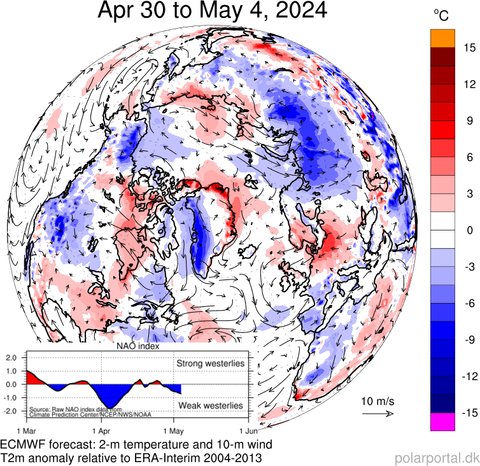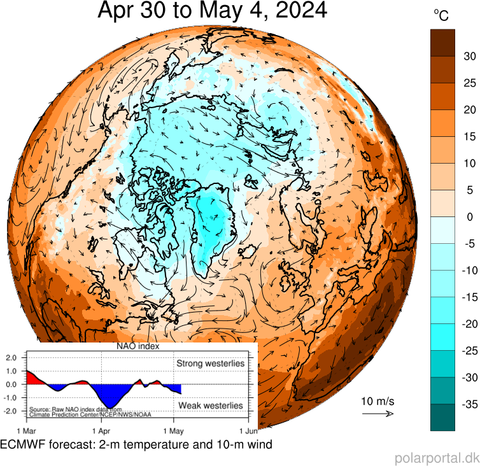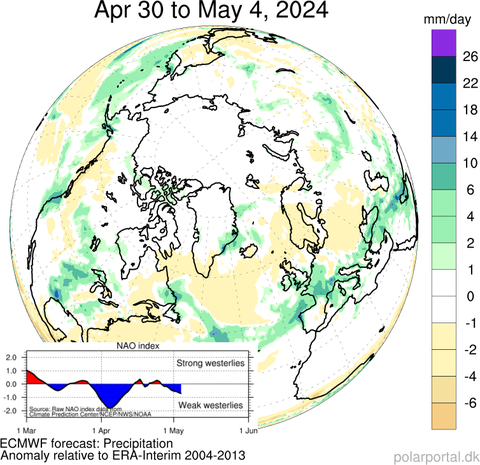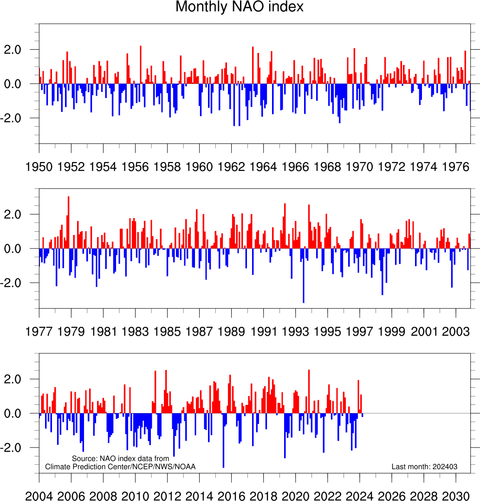Date:
Current Weather
Conditions on the ice sheet and the sea ice in the Arctic are influenced by the weather. The direction and strength of the wind determine how and by how much the sea ice is pushed around. The temperature determines, among other things, how much ice melts.
The animations illustrate the temperature anomaly in relation to average values during the period 2004-2013, in addition to current wind conditions. They are based on daily registrations during the past 50 days. All data is shown as an average over 5 days.
In addition, the NAO index is shown. This is a measure of the strength of the westerly winds in the North Atlantic. When the index is negative, the flow is wavier, which increases the probability of transport of warm air to Greenland from the south.
Conditions on the ice sheet and the sea ice in the Arctic are influenced by the weather. The direction and strength of the wind determine how and by how much the sea ice is pushed around. The temperature determines, among other things, how much ice melts.
The animations illustrate the temperature in addition to current wind conditions. They are based on daily registrations during the past 50 days. All data is shown as an average over 5 days.
In addition, the NAO index is shown. This is a measure of the strength of the westerly winds in the North Atlantic. When the index is negative, the flow is wavier, which increases the probability of transport of warm air to Greenland from the south.
Precipitation anomaly – this illustrates how much precipitation has fallen per day in relation to average values during the period 2004-2013. Precipitation leads to an increase of the mass of the ice sheet.
The animations illustrate the anomaly in relation to mean precipitation based on daily registrations during the past 50 days. All data is shown as an average over 5 days.
In addition, the NAO index is shown. This is a measure of the strength of the westerly winds in the North Atlantic. When the index is negative, the flow is wavier, which increases the probability of the transport of warm air to Greenland from the south.
The monthly NAO index since 1950 is shown here. The NAO index is a measure of the strength of the westerly winds in the North Atlantic. When the index is negative, the flow is wavier, which increases the probability of the transport of warm air to Greenland from the south.
Where does the data come from?
The figures shown are based on data from the European Centre for Medium-Range Weather Forecasts (ECMWF) IFS forecast model. ECMWF is the European weather centre, which is a joint body established by several European countries. Among other things, ECMWF runs global weather models, from which each country can retrieve data to run their local weather models.
Anomalies (deviations from the norm) are calculated in relation to ECMWF’s weather re-analysis, called ERA-Interim. A re-analysis is a review of observations and weather models run over a historical period that ensures consistent mapping of the state of the atmosphere over time.
The North Atlantic Oscillation (NAO)
Generally speaking, there is very often high pressure over the Azores and surrounding areas, whilst there is very often low pressure over Iceland. The pressure difference between the Azores and Iceland varies over time, and this variation is described by the so-called North Atlantic Oscillation (NAO). The NAO index is thus a measure of how strong westerly winds are over the East Atlantic and surrounding regions. If the pressure difference is great, strong westerly winds blow, and we say that the NAO index is positive; if the pressure difference is small, the westerly winds will be light, and the NAO negative. Occasionally, the pressure over Iceland may even be higher than that over the Azores. This will result in an easterly wind and a strongly negative NAO index.
In simple terms, a high NAO index means mild winters and cool summers in large parts of Europe, whilst a negative index results in cold winters and hot summers. It has also been a well-known phenomenon for more than 250 years that it is often cold in Greenland when it is warm in Denmark, and vice versa. When the NAO index is negative, the weak westerly air currents have a tendency to exhibit greater curvature, which increases the probability of warmer air from the south flowing up towards Greenland.
The NAO index can be determined in different ways. It can, for example, be seen directly from measurements of air pressure on Iceland and the Azores or Gibraltar. Re-analyses, however, are performed on a grid, and it is therefore more accurate to use a so-called EOF analysis, which provides more or less the same result, although based on the distribution of pressure throughout the Atlantic region.
The NAO index presented here on this page is calculated by the Climate Prediction Center at NOAA/ National Weather Service, and the calculation is described here.
Daily NAO data is obtained here.
The North Atlantic Oscillation (NAO)
Generally speaking, there is very often high pressure over the Azores and surrounding areas, whilst there is very often low pressure over Iceland. The pressure difference between the Azores and Iceland varies over time, and this variation is described by the so-called North Atlantic Oscillation (NAO). The NAO index is thus a measure of how strong westerly winds are over the East Atlantic and surrounding regions. If the pressure difference is great, strong westerly winds blow, and we say that the NAO index is positive; if the pressure difference is small, the westerly winds will be light, and the NAO negative. Occasionally, the pressure over Iceland may even be higher than that over the Azores. This will result in an easterly wind and a strongly negative NAO index.
In simple terms, a high NAO index means mild winters and cool summers in large parts of Europe, whilst a negative index results in cold winters and hot summers. It has also been a well-known phenomenon for more than 250 years that it is often cold in Greenland when it is warm in Denmark, and vice versa. When the NAO index is negative, the weak westerly air currents have a tendency to exhibit greater curvature, which increases the probability of warmer air from the south flowing up towards Greenland.
The NAO index can be determined in different ways. It can, for example, be seen directly from measurements of air pressure on Iceland and the Azores or Gibraltar. Re-analyses, however, are performed on a grid, and it is therefore more accurate to use a so-called EOF analysis, which provides more or less the same result, although based on the distribution of pressure throughout the Atlantic region.
The NAO index presented here on this page is calculated by the Climate Prediction Center at NOAA/ National Weather Service, and the calculation is described here.
Monthly NAO data is obtained here.













